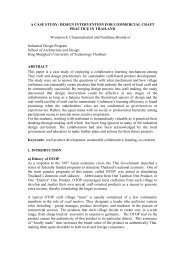soa+d research manual - School of Architecture and Design, KMUTT
soa+d research manual - School of Architecture and Design, KMUTT
soa+d research manual - School of Architecture and Design, KMUTT
Create successful ePaper yourself
Turn your PDF publications into a flip-book with our unique Google optimized e-Paper software.
one written for the humanities: disciplines <strong>and</strong> traditions vary<br />
in terms <strong>of</strong> reviewer expectations, emphasis, structure <strong>and</strong><br />
style. The aim <strong>of</strong> scientific <strong>research</strong> is to describe <strong>and</strong> measure<br />
phenomena <strong>and</strong> the abstract will summarise the scope, purpose,<br />
methodology <strong>and</strong> results <strong>of</strong> the <strong>research</strong>. in humanities <strong>research</strong>,<br />
the emphasis is on interpretation rather than validation, <strong>and</strong> the<br />
abstract will summarise the thesis, context <strong>and</strong> conclusion <strong>of</strong> the<br />
<strong>research</strong> study.<br />
The best way to develop your underst<strong>and</strong>ing <strong>of</strong> the way that<br />
different intellectual fields report their <strong>research</strong> is to search<br />
out <strong>and</strong> read abstracts <strong>and</strong> papers from a range <strong>of</strong> different<br />
conferences. Of course it is <strong>of</strong> particular importance that you<br />
familiarise yourself with the nature <strong>and</strong> expectations <strong>of</strong> any<br />
conference to which you decide to submit your abstract.<br />
bearing in mind the differences mentioned above, it is useful to<br />
remind yourself that, in the final analysis, your abstracts should<br />
outline your response to the following elements (though not<br />
necessarily in this order):<br />
1 Motivation/problem: What practical, scientific, theoretical or<br />
artistic issue/problem does your <strong>research</strong> address? Why would<br />
anyone care about this? Why do you care about it?<br />
2 Methods/procedure/approach: how did you address the issue<br />
or seek to solve the problem? for example: simple: we carried<br />
out a number <strong>of</strong> interviews, we took a series <strong>of</strong> photographs, we<br />
did content analysis <strong>of</strong> an issue in the news; more complex: we<br />
took a series <strong>of</strong> photographs <strong>of</strong> people at the heart <strong>of</strong> an issue<br />
covered in the news <strong>and</strong> interviewed them about press coverage.<br />
3 Results/findings/product/ outcomes/ discoveries: what did you<br />
learn, uncover, discover, prove ...<br />
4 Conclusion/implications: What are the implications <strong>of</strong> point<br />
3 for point 1? Are there any other implications (personal,<br />
disciplinary, socio-cultural <strong>and</strong> so on <strong>and</strong> so forth)?<br />
SOME ExAMPLES<br />
The examples that follow are drawn from a range <strong>of</strong> disciplines<br />
<strong>and</strong> traditions. They also demonstrate another factor that you<br />
should bear in mind: length. Abstracts vary in length from<br />
conference to conference. some can be as short as two hundred<br />
words. Others can reach eight hundred. At this length, the<br />
abstract becomes known as an extended abstract <strong>and</strong><br />
REsEARch NOTEs<br />
19<br />
will require a greater level <strong>of</strong> detail <strong>and</strong> a set <strong>of</strong> references. The<br />
abstracts below are presented as food for thought. it might help<br />
to read them critically using the four point plan opposite as a set<br />
<strong>of</strong> criteria or questions: e.g. how well does the abstract report its<br />
results? or describe its motivation? or relate its methodology to<br />
its issue/theme/problem?<br />
An (annotated) example from an SOAD MfA student<br />
[motivation/significance] This project investigated the sociocultural<br />
role <strong>and</strong> personal significance <strong>of</strong> the postcard. The<br />
project originated in the <strong>research</strong>er’s own experience <strong>of</strong><br />
maintaining contact with friends <strong>and</strong> family whilst working in<br />
an alien culture. it explored the communicative potential <strong>and</strong><br />
meaning <strong>of</strong> the postcard at multiple levels: the subjective,<br />
the touristic, the historical <strong>and</strong> the theoretical. [methodology]<br />
The <strong>research</strong>er used a practice-based <strong>research</strong> methodology.<br />
Theoretical studies <strong>and</strong> field <strong>research</strong> formed the basis <strong>of</strong> a<br />
series <strong>of</strong> experimental design projects. [results] The problems,<br />
issues <strong>and</strong> discoveries encountered were captured in the<br />
concept ‘closing the distance’ <strong>and</strong> these were synthesized in a<br />
final conceptual installation. [implications] The project provided<br />
the opportunity for an extended <strong>and</strong> in depth-exploration <strong>of</strong> an<br />
issue through design practice. As such it enabled the <strong>research</strong>er<br />
to: 1) develop her critical <strong>and</strong> creative abilities; <strong>and</strong> , 2) provide<br />
an original creative response to a topic <strong>of</strong> cultural interest.<br />
An example from design <strong>research</strong><br />
The notion <strong>of</strong> sustainable design has become increasingly<br />
prominent within the design community. As a result, numerous<br />
design theories, strategies <strong>and</strong> tools are available to designers.<br />
yet, limited attempts in the field evaluate these activities by<br />
placing them in relation to each other or within the broader<br />
context <strong>of</strong> sustainable development. based on a literature review<br />
this study develops an integrated framework which connects<br />
the areas <strong>of</strong> sustainable development <strong>and</strong> sustainable design.<br />
This framework may be utilised in two ways: firstly, to visualise<br />
the interdependencies <strong>of</strong> sustainable design <strong>and</strong> sustainable<br />
development; secondly, as an assessment tool to measure <strong>and</strong><br />
compare the potential <strong>of</strong> sustainable design activities/properties<br />
<strong>of</strong> a material might be needed in an embodiment design.<br />
considering these points, it is appropriate to say that design<br />
related disciplines require different materials selection tools <strong>and</strong><br />
methods (than those used in engineering <strong>and</strong> materials science)<br />
which can be used in different phases <strong>of</strong> a design process <strong>and</strong><br />
support designers in underst<strong>and</strong>ing both tangible <strong>and</strong> intangible<br />
aspects <strong>of</strong> a material.



